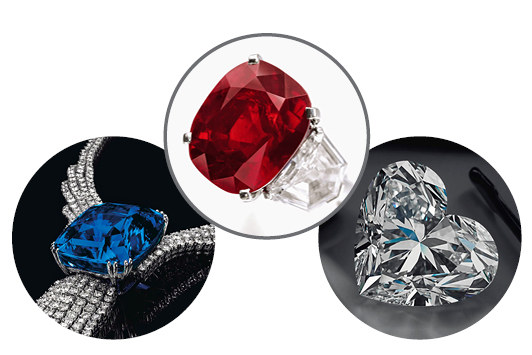
It’s been going on for so long now, it has practically become a given on the auction markets: Fancy-colored diamonds, colored gemstones and signed jewels are attracting the most interest and generating the biggest sales at major auction houses throughout the world.
“It’s less of a trend and more of a shifting of the market for jewelry,” says Tom Burstein, Christie’s head of jewelry for the Americas.
Just a cursory look at auction results from Christie’s and Sotheby’s will show that fancy blue and pink diamonds are commanding the highest prices, regularly setting new world records. Pink and blue diamonds achieved the top five jewelry auction sales of all time and four of the top five sales for the first half of 2017. Competition for the best colored diamonds is quite fierce, Burstein adds.
“Buyers have really well-trained eyes,” he says. “To get top dollar, you need the top color.”
Gary Schuler, chairman of Sotheby’s jewelry division for the Americas, says the auction house has experienced widespread growth in all of its jewelry categories.
“There has certainly been a ravenous desire for the best of the best. People recognize more and more great pieces of jewelry and gemstones and their true rarity. It’s really driving the competition,” he says. “At the other end of the spectrum, there is still this great desire to own fun, wearable jewelry that women are able to dress up and down as they choose.”
Schuler also notes the importance of a good story, whether it involves priceless or affordable jewels. For example, he recounts, a few years ago, a simple pink and yellow gold bracelet with lapis lazuli by Cartier that once belonged to famed German actress Marlene Dietrich sold for $200,000 — well above its $30,000 high estimate — based on its story. It was a gift from her longtime friend, Erich Maria Remarque, author of All Quiet on the Western Front.
“Dietrich’s provenance helped, but it was this overwhelming desire of people to own a great, simple, beautiful, chic jewel with a story that goes with it,” he says. “Those are the things that really drive the market these days.”
As the demand for signed jewels grows, sales of generic jewels — a significant part of major auctions — are struggling, Burstein says.
“There used to be a lot more room for more generic jewelry that looks good and is well-made, but now the appetite for that is significantly lower, to the point that we are becoming very selective and limiting that type of jewelry to include in our auctions.”
The same sluggishness is true for colorless diamonds, which are still growing in value, but at a lackluster pace.
“The [overall] growth has not been tremendous in the last couple of years,” Schuler says. “Where we do still see great interest is in white diamonds over 8 carats. Again, it’s that rarity factor.”
Burstein says demand for colorless diamonds has been consistent the past couple of years, and the market remains stable in some areas.
“Colorless diamonds had a good run in recent years, but in general have not been attracting the explosive prices their colorful siblings have earned,” he comments, though “of course, there are exceptions.”
Buyers are becoming more selective, willing to pay more for better color and more carats, even if it means sacrificing clarity, he continues. They are also relying less on GIA reports and more on their own judgment of a stone’s beauty.
“There’s more of an eye toward connoisseurship, and less objectively to what is on a GIA report,” he says. “I tell buyers, ‘You don’t wear a GIA report on your finger.’... The stopping point where people are willing to sacrifice clarity is SI1.”
Among colored stones, high-quality pigeon blood Burmese rubies, Ceylon sapphires and Colombian emeralds fetch the highest prices, according to Burstein. Untreated gems have even greater value, he says. “Again, it’s a matter of quality.”
Christie’s and Sotheby’s top sales locations are New York, Geneva and Hong Kong — and as one might expect, there are a few regional differences when it comes to the jewels sold in each city. Hong Kong sells top jadeite pieces that are attractive to the Asian market, for instance, while Geneva is known for its sales of royal provenance.
Although the largest and most important auctions generally take place in Geneva, Schuler points out that thanks to digital technology, access to live auctions anywhere in the world has never been easier.
Jewelry sales are increasingly global, and regional differences are being absorbed into one worldwide marketplace.
“It really has turned into quite a global market,” Schuler says. “Last year, I had buyers from over 60 different countries bidding in our salesroom in New York.”
Image (left to right): The Blue Belle of Asia, sold at Sotheby's Geneva; Sunrise Ruby, Cartier ring, sold at Sotheby's Geneva; La Legende, Boehmer et Bassenge, sold at Christie's Geneva.Article from the Rapaport Magazine - October 2017. To subscribe click here.